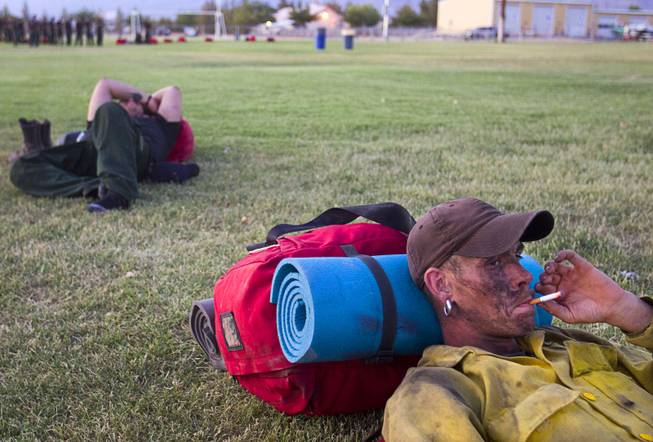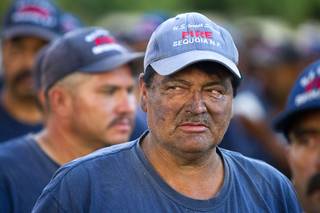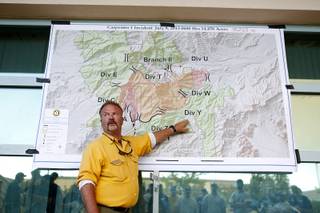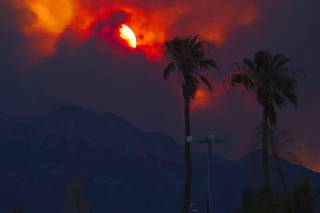
Firefighter Troy Thomas, based in Owyee, Nev. smokes a cigarette before making camp in Pahrump after fighting the Carpenter 1 wildfire Sunday, July 7, 2013.
Tuesday, July 9, 2013 | 2 a.m.
Related stories
- Officials estimate Mount Charleston wildfire won’t be contained until July 19
- For Mount Charleston evacuees, some answers about the nation’s top-priority wildfire
- Mountain’s residents live with constant threat of forest fires
- Crews keep Mount Charleston wildfire at bay, protecting every structure so far
- Mount Charleston called nation’s top wildfire priority; blaze is 15 percent contained
- 45 minutes and a world away: Mount Charleston residents relish life in high-altitude oasis
The day started with eggs and sausage, a hearty breakfast to give the 800-some firefighters battling the Mount Charleston wildfire a calorie boost.
Their Monday would be long: a 12-hour shift, plus a couple of hours for transportation, amid conditions described later by their supervisors as “hot, windy and dry.”
After a 6 a.m. briefing, these men and women working the day shift left the confines of Centennial High School and made their way up the mountainside with this mission in mind: Stop the fire from spreading.
“The fire is more active today, and we expected it,” said Larry Helmerick, a public information officer for the National Incident Management Team. “There are no clouds.”
But the plumes of smoke billowing from the mountain — tinted orange from the sun — could have passed as clouds covering the northwest valley sky late Monday afternoon. Residents snapped photos from sidewalks.
The wildfire started July 1 after lightning apparently struck a tree in the Spring Mountains west of Las Vegas, igniting the Pinyon-Juniper woodland. Authorities estimated its size to be 15,268 acres by Monday evening, but fire crews prevented it from spreading to nearby homes in Rainbow Canyon.
The effort included firefighters from Nevada, Wyoming, California, Colorado, Washington, Oregon, Arizona and New Mexico who heeded the call for help sent via a national fire dispatch system. More could come later this week.
By Monday evening, they totaled 803 and staffed 18 ground crews, seven helicopters, four heavy air tankers, 39 fire engines, 10 water tanker trucks and one very large air tanker known as a VLAT, authorities said.
The firefighters on ground included eight hotshot crews — specially trained firefighters who spend the summer together fighting wildfires and tackling the hottest and steepest points, said James Stone, a retired U.S. Forest Service employee serving as a spokesman for the National Incident Management Team. Nineteen hotshot firefighters died in Arizona on June 30 while fighting the Yarnell Hill Fire.
The fire on Mount Charleston is one of 20 active large fires burning nearly 400,000 acres across the United States, according to the National Interagency Fire Center. Four new fires — three in Idaho and one in California — were reported Monday.
“They go on these big acre-gobbling fires and stay with them as long as needed,” Stone said.
The hotshots, or “shot crews” as they prefer to be called, joined 10 ground crews of Type II firefighters to battle the fire on Mount Charleston, Stone said. Type II firefighters have basic fire training and are deployed in crews of 20.
Ground firefighters use shovels and axes to clear the area of anything that could catch fire — pine needles, twigs, leaves — to create a fireline around the perimeter, preventing the wildfire from spreading, Stone said. Once they have cut a line, firefighters “mop up,” or extinguish fire near the line, in a variety of ways: mixing fire with dirt, chopping fire out of logs and using water hoses whenever possible depending on location, he said.
“You could have miles of hose,” Stone said, explaining the need for other methods of fire extinction.
Air-support resources help by dropping water and fire retardant in certain locations, as well, he said.
On Monday, a 35-page incident action plan detailed the operations for combating the wildfire, which authorities have broken into eight divisions, Helmerick said.
“Each one has a specific work plan for the day, and, of course, it’s subject to change depending on fire needs,” he said.
That’s where the fire camp set up at Centennial High School comes into play. It’s considered the brains of the operation, with departments such as finance, security and safety.
So far, authorities have estimated the fire has cost about $2.4 million, a figure expected to rise each day, Helmerick said. A dozen staff members in the finance department determine the dollar amount based on aircraft fuel and maintenance, equipment rentals, personnel costs, food and water, among other expenses, he said.
The fire camp’s main responsibility, however, is supplying the firefighters with anything they need, whether it’s food, equipment or even a refreshing shower.
Rows of portable shower stalls line the side of the high school because studies have shown that cleaning sweat from pores helps the body’s cooling system function more efficiently, Stone said.
Another necessity: food and water, and lots of it.
Firefighters receive 6,000 calories worth of food a day, which includes two warm meals and a brown-bag lunch. Monday’s lunch, for instance, consisted of a ham and cheese sandwich, a peanut butter-and-jelly sandwich, two boxes of raisins, an apple, string cheese, trail mix, oatmeal raisin cookies, condiments and a wet wipe and paper towel to tidy up with after the meal. (And, yes, there are vegetarian meal options, too.)
They’re carefully calculated meals to replace calories lost while battling the fire, Stone said, while sitting in the camp’s makeshift “mess hall” in a tent outside the school.
Indoor classrooms are used as sleeping quarters for the firefighters.
By 6:15 p.m. Monday, a few dozen firefighters working the night shift assembled in the school’s courtyard for their briefing.
Leaders relayed the day’s events, which included both good and bad news: Windy and dry conditions resulted in some lost ground, but firefighters had saved structures in Rainbow Canyon. Fire containment remained at 15 percent of the perimeter, meaning authorities don’t expect the wildfire to cross that line based on weather forecasts.
Rod Collins, an operation section chief for the National Incident Management Team, left the firefighters with a more personal message, though.
“Be careful out there tonight, all right?” he said.
Dayshift firefighters would return about 8 p.m. Monday. And if they weren’t too groggy, they might have noticed posters hung in the afternoon by high school student council members.
A rectangular one with blue cursive just inside the school’s front doors says, “We love you, firefighters.”




Join the Discussion:
Check this out for a full explanation of our conversion to the LiveFyre commenting system and instructions on how to sign up for an account.
Full comments policy